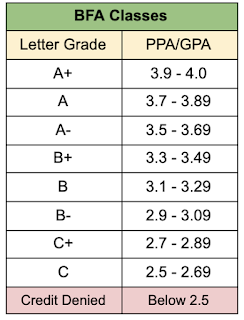Grading System Changes Implemented in Hopes of More Accurate Reporting, Greater Distinction

A chart of the proficiency average to letter grade conversions, which will now be shown on report cards in addition to student transcripts. Photo Credit: Student/Parent Handbook
December 6, 2020
Basic Proficiency? Proficient Plus? Letter-Grade Conversions? The 2020-21 school year comes with many changes to the BFA scoring system after the transcript debacle last fall, and the addition of new proficiency criteria is just one of many.
According to the BFA 2020-21 Student/Parent Handbook, one change made for this school year (that was used last year as well due to remote learning and COVID-19) is the change of requirements in receiving credit for a course. Before last year, students had to receive a “3” or better in each course’s PBGR (proficiency-based graduation requirement) to receive credit. Now, students must hold a course average (an average of all PBGR’s, to the 10ths place) of 2.5 or higher.
Explaining the reasoning behind the change, Assistant Principal Sara Kattam said, “So we’re looking at kind of a bird’s eye view. We want the broad concept of, ‘Does the student understand the writing process?’ There might be one area in the writing process that they’re weaker in, but overall, if they know the writing process, then they’re going to be okay. Having individual scores at the standard level also gives feedback to the student.”
Another change is the addition of “Basic Proficiency” (2.5) and “Proficient Plus” (3.5) scoring options. According to Kattam, this allows teachers to grade their students more accurately.
An issue with BFA’s past proficiency systems, according to many teachers and parents, is that it was difficult to recognize high-achieving students. This year, new, clearer requirements have been set for both honor roll and academic achievement pins.
According to the handbook, if a student has no course average below a 3.0, and has 3’s or better in the Self-Direction and Responsible & Involved Citizenship transferable skills, they will qualify for the honor roll. If a student meets those requirements and additionally has half of their courses at an average of 3.5 or better, they will qualify for the high honor roll.
New this year is also Latin Honors at graduation, something BFA has never executed before, instead only recognizing a valedictorian and salutatorian. Graduates with a cumulative GPA of 3.5 or higher are recognized in three different tiers: Summa Cum Laude for students with a 3.9 GPA or better, Magna Cum Laude for students with a 3.7 – 3.89 GPA and Cum Laude for students with a 3.5 – 3.69 GPA.
Explaining the reasoning for the new honors recognitions, Kattam provided a comparison to athletics, saying, “With sports, you have your players that are on the team; they’re contributing to the team and they’re doing well. And then you also have those kids who are, you know, working extra hard and are your varsity players. I think that that’s an important thing for all students to kind of have their areas where they’re good at, and we want to be able to also give some distinction to students who are achieving academically.”
Overall, it will be interesting to see if the new scoring system stands the test of time that BFA’s former proficiency-scoring system attempts couldn’t.
